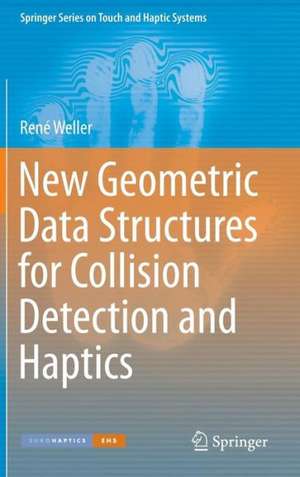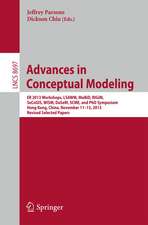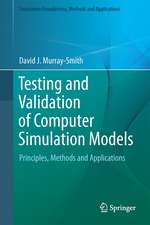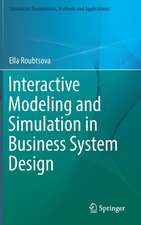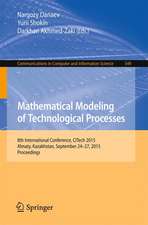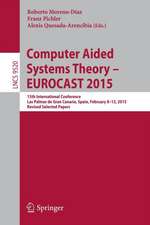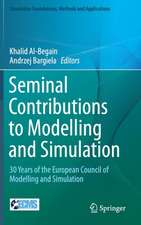New Geometric Data Structures for Collision Detection and Haptics: Springer Series on Touch and Haptic Systems
Autor René Welleren Limba Engleză Hardback – 25 iul 2013
Required in the fields of computer graphics, physically-based simulations, computer animations, robotics and haptics, collision detection is a fundamental problem that arises every time we interact with virtual objects. Some of the open challenges associated with collision detection include the handling of deformable objects, the stable computation of physically-plausible contact information, and the extremely high frequencies that are required for haptic rendering. New Geometric Data Structures for Collision Detection and Haptics presents new solutions to all of these challenges, and will prove to be a valuable resource for researchers and practitioners of collision detection in the haptics, robotics and computer graphics and animation domains.
| Toate formatele și edițiile | Preț | Express |
|---|---|---|
| Paperback (1) | 310.17 lei 38-44 zile | |
| Springer International Publishing – 8 aug 2015 | 310.17 lei 38-44 zile | |
| Hardback (1) | 338.16 lei 6-8 săpt. | |
| Springer International Publishing – 25 iul 2013 | 338.16 lei 6-8 săpt. |
Din seria Springer Series on Touch and Haptic Systems
- 20%
 Preț: 642.65 lei
Preț: 642.65 lei - 20%
 Preț: 643.50 lei
Preț: 643.50 lei - 20%
 Preț: 302.31 lei
Preț: 302.31 lei - 20%
 Preț: 919.07 lei
Preț: 919.07 lei - 20%
 Preț: 689.83 lei
Preț: 689.83 lei - 20%
 Preț: 642.52 lei
Preț: 642.52 lei - 20%
 Preț: 584.91 lei
Preț: 584.91 lei - 20%
 Preț: 644.33 lei
Preț: 644.33 lei - 20%
 Preț: 638.37 lei
Preț: 638.37 lei - 20%
 Preț: 644.33 lei
Preț: 644.33 lei - 20%
 Preț: 644.98 lei
Preț: 644.98 lei - 20%
 Preț: 337.52 lei
Preț: 337.52 lei - 20%
 Preț: 332.24 lei
Preț: 332.24 lei - 20%
 Preț: 651.75 lei
Preț: 651.75 lei - 20%
 Preț: 603.89 lei
Preț: 603.89 lei - 20%
 Preț: 367.61 lei
Preț: 367.61 lei - 20%
 Preț: 588.39 lei
Preț: 588.39 lei - 20%
 Preț: 763.85 lei
Preț: 763.85 lei - 20%
 Preț: 1035.18 lei
Preț: 1035.18 lei - 20%
 Preț: 923.16 lei
Preț: 923.16 lei
Preț: 338.16 lei
Preț vechi: 422.70 lei
-20% Nou
Puncte Express: 507
Preț estimativ în valută:
64.72€ • 67.31$ • 53.43£
64.72€ • 67.31$ • 53.43£
Carte tipărită la comandă
Livrare economică 15-29 aprilie
Preluare comenzi: 021 569.72.76
Specificații
ISBN-13: 9783319010199
ISBN-10: 3319010190
Pagini: 256
Ilustrații: XVI, 240 p.
Dimensiuni: 155 x 235 x 19 mm
Greutate: 0.58 kg
Ediția:2013
Editura: Springer International Publishing
Colecția Springer
Seria Springer Series on Touch and Haptic Systems
Locul publicării:Cham, Switzerland
ISBN-10: 3319010190
Pagini: 256
Ilustrații: XVI, 240 p.
Dimensiuni: 155 x 235 x 19 mm
Greutate: 0.58 kg
Ediția:2013
Editura: Springer International Publishing
Colecția Springer
Seria Springer Series on Touch and Haptic Systems
Locul publicării:Cham, Switzerland
Public țintă
ResearchCuprins
Series Editors’ Foreword.- Preface.- Part I – That was Then, This is Now.- Introduction.- A Brief Overview of Collision Detection.- Part II – Algorithms and Data Structures.- Kinetic Data Structures for Collision Detection.- Sphere Packings for Arbitrary Objects.- Inner Sphere Trees.- Part III – Evaluation and Application.- Evaluation and Analysis of Collision Detection Algorithms.- Applications.- Part IV – Every End is Just a New Beginning.- Epilogue.
Textul de pe ultima copertă
Starting with novel algorithms for optimally updating bounding volume hierarchies of objects undergoing arbitrary deformations, the author presents a new data structure that allows, for the first time, the computation of the penetration volume. The penetration volume is related to the water displacement of the overlapping region, and thus corresponds to a physically motivated and continuous force. The practicability of the approaches used is shown by realizing new applications in the field of robotics and haptics, including a user study that evaluates the influence of the degrees of freedom in complex haptic interactions. New Geometric Data Structures for Collision Detection and Haptics closes by proposing an open source benchmarking suite that evaluates both the performance and the quality of the collision response in order to guarantee a fair comparison of different collision detection algorithms.
Required in the fields of computer graphics, physically-based simulations, computer animations, robotics and haptics, collision detection is a fundamental problem that arises every time we interact with virtual objects. Some of the open challenges associated with collision detection include the handling of deformable objects, the stable computation of physically-plausible contact information, and the extremely high frequencies that are required for haptic rendering. New Geometric Data Structures for Collision Detection and Haptics presents new solutions to all of these challenges, and will prove to be a valuable resource for researchers and practitioners of collision detection in the haptics, robotics and computer graphics and animation domains.
Required in the fields of computer graphics, physically-based simulations, computer animations, robotics and haptics, collision detection is a fundamental problem that arises every time we interact with virtual objects. Some of the open challenges associated with collision detection include the handling of deformable objects, the stable computation of physically-plausible contact information, and the extremely high frequencies that are required for haptic rendering. New Geometric Data Structures for Collision Detection and Haptics presents new solutions to all of these challenges, and will prove to be a valuable resource for researchers and practitioners of collision detection in the haptics, robotics and computer graphics and animation domains.
Caracteristici
State of the art review of the current data structures for collision detection Features a novel geometric data structure for collision detection at haptic rates between arbitrary rigid objects Presents new applications based on the latest research Includes supplementary material: sn.pub/extras
